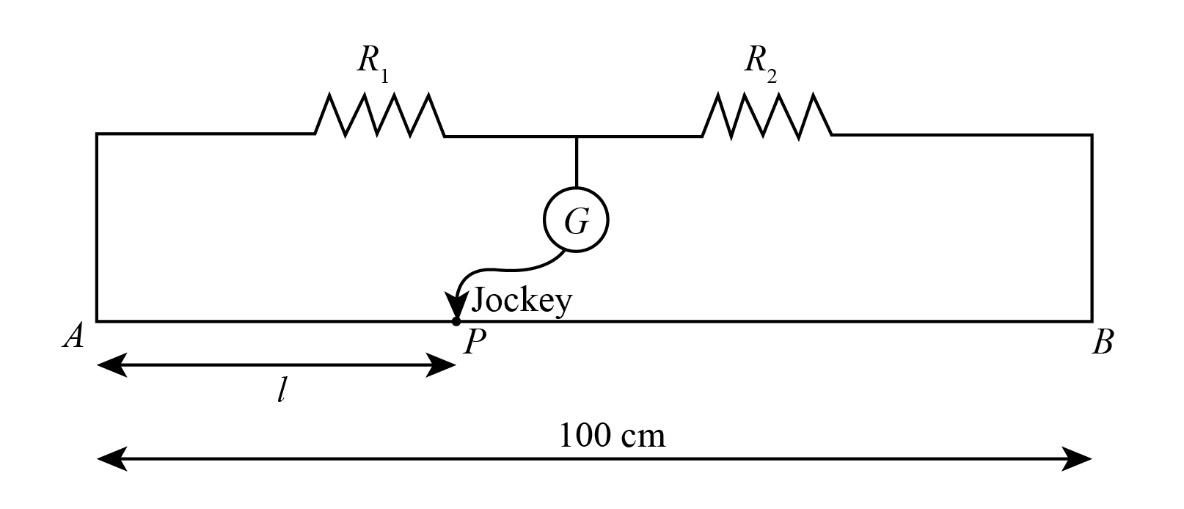
Answer
453.6k+ views
Hint: The ratio of resistances on the left end and right end of the given meter bridge will be equal to the ratio of the distance between the left end and right end and jockey. We will use this expression for the metre bridge to calculate the value of unknown resistance.
Complete step by step answer:
Given:
The balancing length from the left end is \[l = 20{\rm{ cm}}\].
The value of resistance in the right gap is \[{R_2} = 1{\rm{ }}\Omega \].
We have to find the value of unknown resistance \[{R_2}\].

It is given that the metre bridge is in a balanced condition, so the value of the current through the jockey will be zero.
We can write the expression for balanced metre bridge as below:
\[\dfrac{{{R_1}}}{{{R_2}}} = \dfrac{{{\rm{AP}}}}{{{\rm{BP}}}}\]……(1)
We know that the length of the metre bridge is \[100{\rm{ cm}}\].
\[{\rm{AB}} = 100{\rm{ cm}}\]
Therefore from the above diagram, we can say that the distance between point B and point P is \[\left( {100 - l} \right){\rm{ cm}}\].
\[{\rm{BP}} = \left( {100{\rm{ cm}} - l} \right)\]
Substitute \[l\] for AP and \[\left( {100{\rm{ cm}} - l} \right)\] for BP in equation (1).
\[\dfrac{{{R_1}}}{{{R_2}}} = \dfrac{l}{{\left( {100{\rm{ cm}} - l} \right)}}\]
Substitute \[20{\rm{ cm}}\] for l and \[1{\rm{ }}\Omega \] for \[{R_2}\] in the above expression.
\[\begin{array}{l}
\dfrac{{{R_1}}}{{1{\rm{ }}\Omega }} = \dfrac{{20{\rm{ cm}}}}{{100{\rm{ cm}} - 20{\rm{ cm}}}}\\
{R_1} = 0.25{\rm{ }}\Omega
\end{array}\]
Therefore, the value of unknown resistance is \[0.25{\rm{ }}\Omega \]
So, the correct answer is “Option D”.
Note:
In metre bridge, a wire of length one-metre having uniform cross-sectional area is mounted between two clips of metals which are bent at right angles in such a way that the provision for the introduction of two resistors is provided. A battery is connected to the endpoints of the wire. Also, there is a galvanometer whose one end is connected to the strip and another to a jockey. This jockey is moved across the length of the wire, and unknown resistance is calculated.
Complete step by step answer:
Given:
The balancing length from the left end is \[l = 20{\rm{ cm}}\].
The value of resistance in the right gap is \[{R_2} = 1{\rm{ }}\Omega \].
We have to find the value of unknown resistance \[{R_2}\].

It is given that the metre bridge is in a balanced condition, so the value of the current through the jockey will be zero.
We can write the expression for balanced metre bridge as below:
\[\dfrac{{{R_1}}}{{{R_2}}} = \dfrac{{{\rm{AP}}}}{{{\rm{BP}}}}\]……(1)
We know that the length of the metre bridge is \[100{\rm{ cm}}\].
\[{\rm{AB}} = 100{\rm{ cm}}\]
Therefore from the above diagram, we can say that the distance between point B and point P is \[\left( {100 - l} \right){\rm{ cm}}\].
\[{\rm{BP}} = \left( {100{\rm{ cm}} - l} \right)\]
Substitute \[l\] for AP and \[\left( {100{\rm{ cm}} - l} \right)\] for BP in equation (1).
\[\dfrac{{{R_1}}}{{{R_2}}} = \dfrac{l}{{\left( {100{\rm{ cm}} - l} \right)}}\]
Substitute \[20{\rm{ cm}}\] for l and \[1{\rm{ }}\Omega \] for \[{R_2}\] in the above expression.
\[\begin{array}{l}
\dfrac{{{R_1}}}{{1{\rm{ }}\Omega }} = \dfrac{{20{\rm{ cm}}}}{{100{\rm{ cm}} - 20{\rm{ cm}}}}\\
{R_1} = 0.25{\rm{ }}\Omega
\end{array}\]
Therefore, the value of unknown resistance is \[0.25{\rm{ }}\Omega \]
So, the correct answer is “Option D”.
Note:
In metre bridge, a wire of length one-metre having uniform cross-sectional area is mounted between two clips of metals which are bent at right angles in such a way that the provision for the introduction of two resistors is provided. A battery is connected to the endpoints of the wire. Also, there is a galvanometer whose one end is connected to the strip and another to a jockey. This jockey is moved across the length of the wire, and unknown resistance is calculated.
Recently Updated Pages
Who among the following was the religious guru of class 7 social science CBSE

what is the correct chronological order of the following class 10 social science CBSE

Which of the following was not the actual cause for class 10 social science CBSE

Which of the following statements is not correct A class 10 social science CBSE

Which of the following leaders was not present in the class 10 social science CBSE

Garampani Sanctuary is located at A Diphu Assam B Gangtok class 10 social science CBSE

Trending doubts
A rainbow has circular shape because A The earth is class 11 physics CBSE

Which are the Top 10 Largest Countries of the World?

Fill the blanks with the suitable prepositions 1 The class 9 english CBSE

The Equation xxx + 2 is Satisfied when x is Equal to Class 10 Maths

How do you graph the function fx 4x class 9 maths CBSE

Give 10 examples for herbs , shrubs , climbers , creepers

Who gave the slogan Jai Hind ALal Bahadur Shastri BJawaharlal class 11 social science CBSE

Difference between Prokaryotic cell and Eukaryotic class 11 biology CBSE

Why is there a time difference of about 5 hours between class 10 social science CBSE




